If you or someone you know has been diagnosed with high LDL cholesterol it’s important to understand what cholesterol is and why it’s important to keep it under control. cholesterol is a fat-like substance made by your liver and also comes from foods you intake that are then packaged into particles called lipoproteins. Your body requires cholesterol to make vitamin D, hormones, and a substance that assists you in digesting food called bile.
In this blog, we will discuss two types of lipoproteins that carry cholesterol, low-density lipoprotein or LDL cholesterol also known as bad cholesterol, and high-density lipoprotein or HDL cholesterol also known as good cholesterol. LDL travels through your bloodstream delivering cholesterol to the cells that need it.
if the individual body has too much LDL cholesterol it can build up in the walls of the arteries. Higher levels of LDL in your artery wall form a fatty deposit called plaque. Over time plaque can narrow the artery and reduce blood flow. LDL carries cholesterol into the plaque this is why LDL is called bad cholesterol. This plaque can build up in your coronary arteries which are the blood vessels that feed your heart.
Plaque is made up of cholesterol deposits. Plaque deposits causes the inside of the arteries to narrow over time. This process is called atherosclerosis.
This plaque buildup causes coronary artery disease and increases your risk of a heart attack. Plaque deposits in other arteries such as the carotid arteries in your neck can decrease blood flow to your brain and raise the risk of a stroke.
your liver also makes high-density lipoprotein or HDL also known as the good cholesterol HDL helps remove excess cholesterol from your cells and tissues and form plaque in your blood vessels this is why HDL is called the good cholesterol. HDL returns the cholesterol to your liver which removes it from your body. Read more about HDL Cholesterol .
What are triglycerides?
A triglyceride is a type of fat that is found in our blood, it’s a fat molecule made up of a glycerol unit and three fatty acid chains. Triglycerides come from vegetable oils, and meat and dairy products. Our bodies also create triglycerides from the extra calories we gulp. Triglycerides are packaged inside lipoproteins and transit in the bloodstream to cells throughout the body.
The lipoproteins provide triglycerides to the cells for use as energy, however, if cells do not need that energy, the triglycerides are shipped to fat cells and kept there for future energy use as body fat. Fat cells then hold the triglyceride molecules until your body requires the energy, such as between meals.
Why is this important? Well, high levels of triglycerides in the bloodstream are connected to coronary artery disease, which is when plaque builds up in the arteries that guide the heart. High triglycerides are also linked to an increased risk of stroke and pancreatitis, which can lead to hormone and enzyme disorders. A simple blood test can tell whether your triglycerides fall into a healthy range.
What level of LDL cholesterol is bad?
LDL bad cholesterol is over 200 let’s just put that first into context what should LDL be? Most cardiologists would say everyone’s LDL or bad cholesterol should fall under 130. As you accumulate risk factors that might be high blood pressure or a history of smoking a family history of heart disease closer to 100 would be better.
People who have had a heart attack, stroke bypass surgery, or stent should’ve very abnormal coronary calcium score, for example, closer to 70 would be ideal, and then there’s even data to suggest that under 50 is additionally protective okay to put this in perspective when we are born our LDL is somewhere between 35 and 55 so very very low we don’t need a lot of ldl for cell growth and cell maintenance and the ldl in those populations where people experience exceptional healthy longevity those blue zones their average LDL is around 90
LDL cholesterol levels chart
| Total Cholesterol | LDL (Low-Density Lipoprotein) Cholesterol | HDL (High-Density Lipoprotein) Cholesterol | Triglycerides | |
| Desirable | Less than 200 mg/dL | Less than 100 mg/dL | 40 mg/dL or higher | Less than 150 mg/dL |
| Borderline to moderately elevated | 200 to 239 mg/dL | 100 to 129 mg/dL | N/A | 150 to 199 mg/dL |
| High | 240 mg/dL or higher | 130 to 159 mg/dL | N/A | 200 to 499 mg/dL |
| Very High | Same as above | 160 mg/dL or higher | N/A | 500 mg/dL or higher |
Symptoms of high Ldl Cholesterol, You Shouldn’t Ignore
Yellowish bumps around the eyes
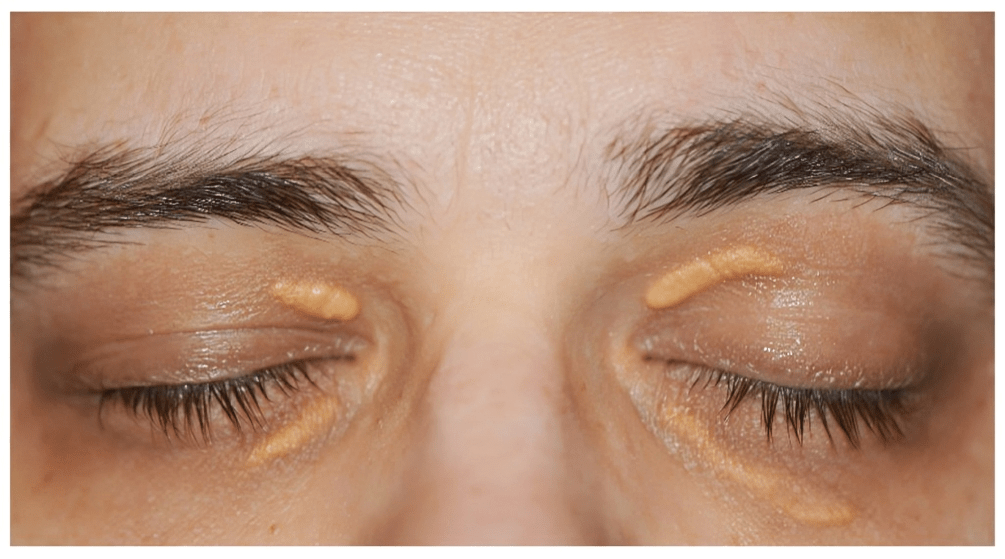
Yellowish bumps around the eyes also known as xanthelasma can be a sign of high cholesterol levels. These bumps are caused by the accumulation of cholesterol and other lipids Under the skin.
They usually appear on or around the eyelids but can also occur on other parts of the body such as the elbows knees and hands. Xanthelasma can be a cosmetic concern for some people but it can also be an indicator of underlying health issues such as high cholesterol levels or liver disease.
If you notice yellowish bumps around your eyes it is necessary to talk to your doctor to determine the underlying cause and receive appropriate treatment. Your doctor May recommend lifestyle Changes medication or other treatments to lower your cholesterol levels and reduce the risk of heart disease and stroke.
Chest pain or angina
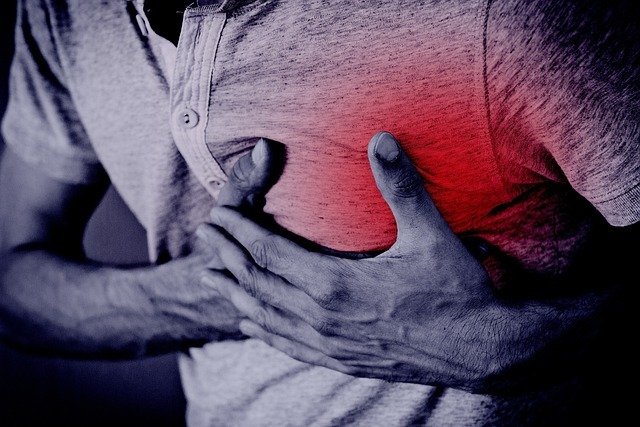
Chest pain or angina is a common symptom of high cholesterol levels. Angina is a kind of chest pain that happens when the heart muscle does not obtain enough oxygen-rich blood. It can feel like pressure or squeezing in the chest and it may also spread to the shoulders arms neck jaw or back.
Angina can be triggered by physical activity or emotional stress and usually subsides with rest angina is a serious condition that can lead to a heart attack if left untreated. If you experience chest pain or discomfort it is essential to seek medical attention immediately your doctor May perform tests to determine the cause of your symptoms such as a coronary angiogram or an electrocardiogram.
Treatment for Angina may include Lifestyle Changes medication or surgery depending on the severity of the condition. It is important to work closely with your doctor to manage your symptoms and reduce the risk of complications.
Shortness of breath

Shortness of breath is another common symptom of high LDL cholesterol levels when cholesterol builds up in the arteries it can reduce the flow of oxygen-rich blood to the lungs leading to shortness of breath.
This symptom may be more prominent during physical activity or when lying down. Shortness of breath can be a sign of a serious underlying condition such as heart disease or lung disease If you experience shortness of breath especially if it is sudden or unbearable it is important to seek medical attention instantly.
Your doctor May perform tests such as a chest x-ray or a pulmonary function test to determine the cause of your symptoms. Treatment for shortness of breath will depend on the underlying cause if high LDL cholesterol levels are contributing to your symptoms your doctor May recommend Lifestyle Changes such as a healthy diet and regular exercise to lower your cholesterol levels in some cases medication may also be necessary to reduce cholesterol levels and improve breathing.
It is important to work closely with your doctor to manage shortness of breath and reduce the risk of complications in some cases shortness of breath can be a sign of a life-threatening condition such as a heart attack or pulmonary embolism therefore it is essential to seek medical attention If you experience.
Tingling in the hands or feet
Tingling in the hands or feet can be a sign of high LDL cholesterol levels. When cholesterol builds up in the blood vessels it can reduce blood flow to the extremities leading to nerve damage and numbness or tingling Sensations.
This symptom may be more noticeable in the fingers or toes but can also occur in the hands or feet. Numbness or tingling in the hands or feet can also be a sign of other underlying conditions such as diabetes or peripheral neuropathy. If you experience these symptoms it is important to seek medical awareness to find out the cause and receive appropriate treatment.
Numbness or tingling in the hands or feet will depend on the underlying cause if high LDL cholesterol levels are contributing to your symptoms your doctor May recommend Lifestyle Changes such as a healthy diet and regular exercise to lower your cholesterol levels in some cases medication may also be necessary to reduce cholesterol levels and improve nerve function.
Swollen feet or ankles
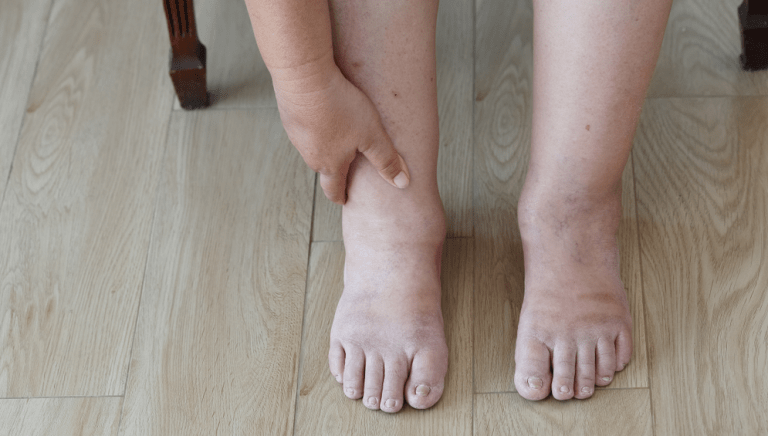
Swollen feet or ankles can also be a sign of high cholesterol levels. When cholesterol builds up in the blood vessels it can reduce blood flow to the legs and feet leading to fluid buildup and swelling.
This symptom may be more noticeable after prolonged periods of standing or sitting and may be accompanied by a feeling of heaviness or discomfort. Swollen feet or ankles can also be a sign of other underlying conditions such as heart or kidney problems.
If you experience these symptoms it is important to seek medical attention to determine the cause and receive appropriate treatment for swollen feet or ankles will depend on the underlying cause if high cholesterol levels are contributing to your symptoms.
Your doctor May recommend Lifestyle Changes such as a healthy diet and regular exercise to lower your cholesterol levels. In some cases, medication may also be necessary to reduce cholesterol levels and improve the circulation number.
Fatigue or weakness

fatigue or weakness can be a sign of high cholesterol levels when cholesterol builds up in the arteries. it can reduce blood flow to the muscles leading to feelings of fatigue or weakness.
This symptom may be more noticeable during physical activity or after prolonged periods of inactivity Fatigue or weakness can also be a sign of other underlying conditions such as anemia or thyroid problems. If you experience these symptoms it is important to seek medical attention to determine the cause and receive appropriate treatment treatment
It is essential to note that many people with high cholesterol levels may not experience any symptoms which is why it is crucial to monitor your cholesterol levels regularly especially if you have a family history of heart disease or stroke are overweight or obese have high blood pressure or diabetes smoke or leads a sedentary lifestyle .
if you have any of these symptoms or risk factors you should talk to your doctor about getting your cholesterol levels checked your doctor May recommend Lifestyle Changes such as following a healthy diet losing weight exercising regularly and quitting smoking in some cases medication may be necessary to lower cholesterol levels and reduce the risk of heart disease and stroke
In conclusion, high cholesterol levels can have serious health consequences but many people may not experience any symptoms therefore it is essential to monitor your cholesterol levels regularly and make lifestyle changes if necessary if you have any of the symptoms mentioned above or risk factors for high cholesterol talk to your doctor about getting your cholesterol levels checked
What causes high LDL cholesterol?
Unhealthy Diet
Overconsumption of food, especially refined carbohydrates. foods high in added sugars can raise levels, and consumption of meats that are high in fat,
Excessive Alcohol Consumption
Alcohol consumption can also increase LDL levels. Alcohol has a particularly potent effect on levels,
Lack of Physical Activity
Lack of regular exercise contributes as well to raising the level of LDL cholesterol
Genetics and Family History
Bad cholesterol is known to be influenced by our genetics some people with high cholesterol may find this runs in their family and can represent a genetic disorder in how your body controls your levels of cholesterol.
If you are diagnosed with this genetic condition you may hear your doctor use the term familial hyperlipidemia which sounds very clever but rarely just stands for family high blood fat. your ethnic group can also influence your risk of high cholesterol with higher rates seen amongst those patients from southern Asian countries
Smoking
Smoking damages the blood vessels I mentioned when you cut your skin same thing happens on those blood vessels you get that clot okay it gets very sticky. Smoking can cause more of that plaque to build up in those different areas.
Smoking damages blood vessels and decreases HDL cholesterol. It can also increase the oxidation of LDL cholesterol, making it more harmful.
Certain Medical Conditions
When you have diabetes having too much glucose also called sugar in your blood can make it harder for blood to flow around your body. Having high cholesterol or blood fats can make things even worse So let’s take a look at how high blood sugars and high cholesterol can cause problems in people with diabetes Here’s a blood vessel. You’ve got blood vessels all over your body They carry blood to your vital organs like your heart, your kidneys, and your brain.
Your blood is made up of lots of individual blood cells When there’s too much sugar in the blood your blood cells start to get sticky and stick to the inside wall of your blood vessels the walls of your blood vessels also get sticky and this can cause other things in your blood to stick to the walls as well like cholesterol.
Cholesterol is a type of fat in the blood and when this fatty material meets the sticky lining caused by high blood sugars it can start to build up and form a clump. This clump can act like a speed bump for the blood cells and stop them from flowing through the blood vessels properly. So high cholesterol combined with high sugars results in more problems for your blood flow.
This means your blood can’t flow to the place it’s needed, like your heart, and this can lead to problems like heart disease. You can reduce your risk of serious complications by taking action to keep your blood sugars and cholesterol at your target level.
Hypothyroidism and kidney disease can influence cholesterol metabolism and help to trigger high LDL cholesterol.
Obesity
Obesity is related to higher LDL cholesterol, higher triglyceride levels, cholesterol levels, and lower HDL cholesterol levels. Obesity can also result in heart disease, high blood pressure, and diabetes.
Talk with your healthcare team about a plan to reduce your weight to a healthy level. Higher body weight, particularly abdominal obesity, is directly linked with higher LDL cholesterol levels. Losing weight via a combination of diet and exercise can help enhance cholesterol profiles
Age and Gender
LDL Cholesterol levels can vary with age, and men tend to have higher LDL cholesterol levels than premenopausal women. However, after menopause, women’s LDL cholesterol levels can increase.
7 Tips to Lower Cholesterol Fast
Eat a Heart-Healthy Diet
Reduce Saturated and Trans Fats
what’s more important is the type of fat which is the saturated fat and the trans fat, those make the biggest difference. So if you want to impact your blood cholesterol level the most important thing you can do is to limit saturated and avoid trans fat.
what’s an unsaturated fat what’s bad fat and good fat how do you tell the difference so well let’s go through it and hopefully that will just kind of clear the confusion and make it pretty clear so statute that natural fat raises your blood cholesterol unsaturated fat lowers your blood cholesterol.
if you just look at fat when it’s like by itself like butter it’s solid at room temperature sitting there at room temperature it’s solid they even have a butter carving contest in that was it Wisconsin or something it’s solid you can carve it sits there if it’s solid it’s saturated so that’s a way to remember it solid saturated solid fats clog up your arteries unsaturated fats they lower your blood cholesterol.
If you just look at them like canola oil it’s liquid so fats that are softer or closer to a liquid at room temperature they’re going to be better for your cholesterol. what kind of fat is it at room temperature is solid or liquid that tells you if is it mostly saturated or is it mostly unsaturated.
if it’s solid it’s gonna be mostly saturated fat so where do we get this most saturated fats the solid fats mostly come from animals but also some from some tropical oils and unsaturated fats mostly come from plants but also you get some from fish so animal fat saturated plant fat unsaturated but there are a couple of exceptions so things that have to live in a cold place like fish cold ocean water .
they have to have a liquid kind of fat so they can wiggle and the fat in them coconuts or whatever it has to be a little bit more solid if it’s gonna stay in the coconut and not drip down the tree so it makes logical sense so solid fats raise your cholesterol liquid fats lower it.
you want to limit your saturated fat so hopefully, this kind of helps you kind of distinguish the kind of fats what they do, and where they come from so what about trans-fat this is one it’s simple just avoid it.
you don’t want it it’s super bad it’s like okay trans fat and not only raises the LDL Cholesterol I remember that’s the lousy one but the lower the better. trans fat is also solid at room temperature so those solid fats clog things up like stick margarine it just is not healthy so time is gonna be better than stick margin and most trans fats.
we get it man-made through a chemical process called partial hydrogenation so if you see that phrase on a label that’s a clue that its man-made trans fat there is some trans fat that occurs naturally in dairy foods and animal fats .
There’s some research showing that that is not as harmful and some there’s a small there’s one type of trans fat but even some research says it may be beneficial but that’s kind of a small side issue of kind of trivial type thing because if you have trans fat you know nine times out of ten it’s man-made and it’s not good for you.
Fiber-Rich Foods
The second factor to pay attention to is fiber you want to get enough fiber in foods vegetables fruits whole grains nuts beans and seeds. Now when we look at just fiber all by itself it’s a little bit confusing in the research but thinks of fiber more like a handle nutrient like the handle on a suitcase if you go and you grab fiber it comes with a whole suitcase full of other good things for your heart phytochemicals antioxidants things that affect how your blood clots or doesn’t clot how your arteries stay healthy and smooth.
so it’s not just about you can’t say oh it’s fiber so I’m gonna go get some fiber supplement this powder or something no fiber you want to look for fiber foods. so if you look for foods that have more fiber that again as a handle so you grab the fiber you look for the fiber and that’s gonna pull all kinds of other good things with it now there is we’re gonna talk about later about a certain type of fiber that you do want to kind of seek out by itself it’s called soluble fiber and that’s because it kind of soaks up cholesterol so but here we are the first two food things to pay attention to is the kind of fat you eat and getting more of the fiber foods
Caloric restriction
The third factor is fuel so we have fat fiber and fuel fuel has to do with the calories you eat so if you have excess calories you’re going to have excess fat in your blood and on your body so you want to watch portion sizes you know also pay tended to sugary drinks that just have empty calories too many of those can drive up blood fats in the body so those are the three main nutritional things change the kind of fat get more of the fiber foods and watch the amount of fuel or calories
Regular Exercise

Exercise has been proven to increase the hdl cholesterol count in the body therefore reducing the ratio of LDL cholesterol and reducing your risk of coronary heart disease. So what exercise is best well any exercise is good and anything would be beneficial but studies have shown that longer-intensity exercise does have an advantage in reducing cholesterol levels .
more than short-term high-intensity exercise so examples would be going for a walk or a jog or running and cycling to work or for recreation swimming has also been found to be highly beneficial by reducing the risk of mortality. So if this is something you enjoy it’s highly recommended.
Fortunately, there are no limitations to exercise even if you’ve been diagnosed with high cholesterol and even if you’re medicated for it such as taking statins obviously as with all conditions it will be dependent on whether you have additional health conditions alongside the high cholesterol but having high cholesterol level by itself doesn’t restrict.
Quit Smoking
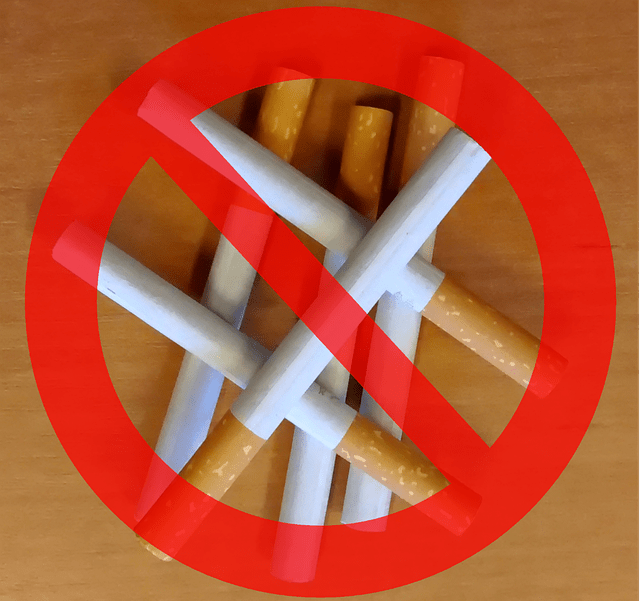
Quitting smoking can lower the LDL cholesterol level. Smoking you know we all know that quitting smoking does all kinds of good things for your body. Avoiding tobacco or quitting tobacco is good for your cholesterol levels.
smoking is so bad for your heart and smoking truly is one of the worst things we could do not just for your heart but for your brain and your lungs and all sorts of things I know that one of the sad statistics is that younger people are taking up smoking and they think vaping is safe.
It is no it’s really bad for your lungs but these risk factors are additive right so if you smoke and you have high chances of high cholesterol. You have now doubled your risk you smoke you have high blood pressure and you have cholesterol. it’s addictive it’s addictive. So cholesterol is just one of the many items to add to the list of justifications to quit smoking.
By losing weight
All of the things that we have been talking about today can help with this, but studies have shown that just by losing weight you can have a positive impact on your cholesterol. Several studies have shown that no matter the weight loss plan helped increase the good HDL and decrease the bad LDL.
Limit Alcohol Intake
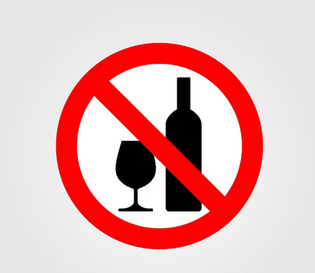
Alcohol’s impact on cholesterol it’s essential to consider two types of cholesterol low-density lipoprotein LDL commonly known as bad cholesterol and high-density lipoprotein HDL known as good cholesterol.
let’s see how alcohol affects each of them does alcohol increase LDL cholesterol, unfortunately, the answer is yes alcohol consumption can raise LDL cholesterol levels. This is primarily due to the ethanol content in alcohol which our bodies metabolize into triglycerides
Triglycerides are a type of fat and increased triglyceride levels can contribute to higher LDL cholesterol levels. Does alcohol decrease HDL cholesterol interestingly the impact of alcohol on HDL cholesterol is a bit different moderate alcohol consumption May modestly increase HDL cholesterol levels.
HDL cholesterol plays a protective role by removing excess cholesterol from the bloodstream and carrying it to the liver for disposal While alcohol can boost HDL levels excessive drinking can reverse this effect and lead to a decrease in HDL cholesterol.
Conclusion
In conclusion, adopting a heart-healthy lifestyle can play an important role in managing and reducing cholesterol levels, particularly LDL cholesterol. A balanced diet rich in fiber, and omega-3 fatty acids, and low in saturated and trans fats is essential to adopt. Regular aerobic exercise, reducing obesity, maintaining a healthy weight, and avoiding smoking are equally crucial contributors to cardiovascular health. For those requiring additional support, medications prescribed by healthcare professionals may be considered.
Explore more valuable insights and tips on health, wellness, and lifestyle in our other blog posts related article Know all about HDL Cholesterol Multiple Sclerosis Cause, Symptoms, Diagnosis and Treatment What Is Epidemiology? History, Causation, Prevention Mental Health: Disorder, Symptoms, Diagnosis


